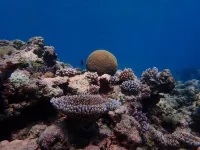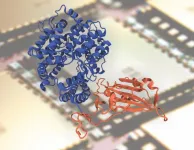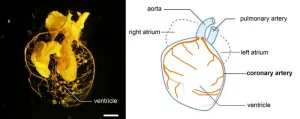(Press-News.org) Coral reefs in one part of the Pacific Ocean have likely adjusted to higher ocean temperatures which could reduce future bleaching impacts of climate change, new research reveals.
A Newcastle University-led study focused on the Pacific Island nation of Palau and has shown that historic increases in the thermal tolerance of coral reefs are possible. The results demonstrate how this capacity could reduce future bleaching impacts if global carbon emissions are cut down.
Drawing on decades of field observations, the scientists modelled many possible future coral bleaching trajectories for Palauan reefs, each with a different simulated rate of thermal tolerance enhancement. They found that if coral thermal tolerance continues to rise throughout the 21st century at the most-likely historic rate, significant reductions in bleaching impacts are possible.
Published in the journal, Nature Communications, the results affirm the scientific consensus that the severity of future coral bleaching depends on carbon emissions reductions. High-frequency bleaching can be fully mitigated at some reefs under low-to-middle emissions scenarios where, for example, the Paris Agreement commitments are fulfilled. However, such bleaching impacts are unavoidable under high emissions scenarios where society continues to rely on fossil-fuelled development.
Study lead author, Liam Lachs, is a part of Newcastle University’s Coralassist lab. “Our study indicates the presence of an ecological resilience to climate change, yet also highlights the need to fulfil Paris Agreement commitments to effectively preserve coral reefs,” Lachs said. “We quantified a natural increase in coral thermal tolerance over decadal time scales which can be directly compared to the rate of ocean warming. While our work offers a glimmer of hope, it also emphasises the need for continued action on reducing carbon emissions to mitigate climate change and secure a future for these vital ecosystems.”
Study co-author, Dr James Guest, of Newcastle University’s School of Natural and Environmental Sciences, added: “We know that coral reefs can increase their overall thermal tolerance over time by acclimatisation, genetic adaptation or shifts in community structure, however we know very little about the rates at which this is occurring. This study uses data from a remote Pacific coral reef system and estimates the rate of increase in tolerance since the late 1980s. The results provide some hope that reefs can keep up with increasing temperatures, but only if strong action is taken on climate change.”
This study was the result of a collaborative visit the lead author undertook in 2021 to work with Professor Simon Donner’s Climate and Coastal Ecosystems Laboratory at the University of British Columbia, Canada. “This study shows the potential for some coral reefs to become more resilient to future climate change-fuelled heat waves,” Prof. Donner said. “That resilience, however, can also come at a cost, in terms of reduced reef diversity and growth. Without sharp cuts in greenhouse gas emissions over the next two to three decades, the reefs in the Pacific won’t provide the resources and protection from waves that Pacific peoples have depended upon for centuries.”
The future of coral reefs
Coral reefs harbour remarkable levels of biodiversity, yet also face unprecedented declines due to marine heatwaves and resulting mass coral bleaching and mortality events. To persist under climate change, coral communities need to endure progressively more intense and frequent marine heatwaves.
The rate at which the thermal tolerance of coral reefs can increase naturally and whether this can match the pace of ocean warming has remained largely unknown. To fill this knowledge gap and offer insights into the future resilience of coral communities, the team from Newcastle University investigated historic mass bleaching events, with a focus on the case study of Palau, a remote Pacific coral reef system.
The study also tested different levels of global action to mitigate climate change and reduce carbon emissions, investigating four emissions scenarios and their impact on future coral bleaching projections.
The findings reveal that the thermal tolerance of corals in Palau has likely increased at a rate of 0.1 °C per decade since the late 1980s. This increase suggests that natural mechanisms, such as genetic adaptation or acclimatization of corals or their symbiotic microalgae, could have contributed to the enhancement of coral thermal tolerance. Study co-author Prof. Peter Mumby of the University of Queensland and Palau International Coral Reef Center reflects that “some of the upcoming challenges will be to disentangle which mechanisms have driven these potential shifts in tolerance, and to understand the possibility of continued future increases in thermal tolerance.”
Reference
Emergent increase in coral thermal tolerance reduces mass bleaching under climate change. Nature Communications. Liam Lachs, Simon Donner, Peter J. Mumby, John C. Bythell, Adriana Humanes, Holly K. East, James R. Guesthttps://doi.org/10.1038/s41467-023-40601-6
--ends--
END
Pacific coral reef shows historic increase in climate resistance
2023-08-22
ELSE PRESS RELEASES FROM THIS DATE:
Researchers extract ancient DNA from a 2,900-year-old clay brick, revealing a time capsule of plant life
2023-08-22
For the first time, a group of researchers have successfully extracted ancient DNA from a 2,900-year-old clay brick.
The analysis provides a fascinating insight into the diversity of plant species cultivated at that time and place, and could open the way to similar studies on clay material from other sites and time periods.
The results are published today in Nature Scientific Reports.
Currently housed at the National Museum of Denmark, the clay brick originates from the palace of Neo-Assyrian king Ashurnasirpal II, in the ancient city of Kalhu. Known today as the North-West palace in Nimrud (modern-day northern Iraq), its construction began around 879 BCE. ...
Exascale revolution: Supercomputers unleash a new era in biophysics discovery
2023-08-22
In a recently published article featured on the cover of the Biophysical Journal, Dr. Rafael Bernardi, assistant professor of biophysics at the Department of Physics at Auburn University, and Dr. Marcelo Melo, a postdoctoral researcher in Dr. Bernardi's group, shed light on the transformative capabilities of the next generation of supercomputers in reshaping the landscape of biophysics.
The researchers at Auburn delve into the harmonious fusion of computational modeling and experimental biophysics, providing a perspective for a future in which discoveries ...
Origins of coronary arteries
2023-08-22
Coronary arteries are a vital part of the human heart, providing it with oxygen-rich blood so that it can work. By comparing the hearts of mammals, birds, reptiles, fish and frogs, a multi-institutional team of researchers appears to have found evidence that the structure of our hearts evolved in a stepwise process from fish, through amphibians to reptiles to mammals. When animals evolved from living in the water to living on land, a significant remodeling of the blood vessels to the heart occurred, enabling survival without gills. Understanding ...
Novel research reveals existence of altered mesocortical connectivity in obesity
2023-08-22
ROCKVILLE, Md.—For the first time, researchers have discovered that the ventral tegmental area (VTA) of the brain—a key structure involved in motivation and reward appreciation has altered connectivity patterns with specific brain regions in patients with obesity. Individuals with obesity have hyper-connectivity of the VTA with part of the ventral occipitotemporal cortex (visual processing for food images) and hypo-connectivity with the left inferior frontal gyrus (associated with cognitive control), according to a new study in Obesity, ...
Study confirms long-term benefits of weight loss surgery in the prevention of cancer
2023-08-22
ROCKVILLE, Md.—After adding follow-up years, increased sample sizes and examining multiple surgical procedures, new research shows bariatric surgery is associated with lower all-cancer and obesity-related cancer incidence among females. The research also found that cancer mortality was significantly lower among female surgical patients compared to non-surgical subjects, according to a new study in Obesity, The Obesity Society’s (TOS) flagship journal.
Although population studies have established a positive association between body mass index and cancer incidence, less clear is whether voluntary ...
Heart attack patients should take aspirin to avoid a new heart attack, stroke and death
2023-08-22
Amsterdam, Netherlands – 22 Aug 2023: Heart attack patients who do not take daily aspirin have an elevated likelihood of recurrent myocardial infarction, stroke or death compared with those who consistently take the drug, according to research presented at ESC Congress 2023.1
“Our findings suggest that not taking aspirin as prescribed after a heart attack is linked to a higher risk of having another heart attack, a stroke or dying,” said study author Dr. Anna Meta Kristensen of Bispebjerg and Frederiksberg Hospital. Frederiksberg, Denmark. ...
Heart attack victims who recognise symptoms are less likely to die in hospital
2023-08-22
Amsterdam, Netherlands – 22 Aug 2023: Recognising and acting on heart attack symptoms is linked with faster life-saving treatment, according to research presented at ESC Congress 2023.1
“Patients with a repeat heart attack were more likely to know the symptoms than first-time sufferers, but recognition was low in both groups,” said study author Dr. Kyehwan Kim of Gyeongsang National University Hospital, Jinju, Republic of Korea. “Most patients could identify chest pain but less than one-third knew the other symptoms.”
Heart attack symptoms can include chest pain, radiating pain to the arms, jaw and neck, dizziness, ...
Keep fit to avoid heart rhythm disorder and stroke
2023-08-22
Amsterdam, Netherlands – 22 Aug 2023: A study in more than 15,000 people has found that physical fitness is linked with a lower likelihood of developing atrial fibrillation and stroke. The research is presented at ESC Congress 2023.1
Atrial fibrillation is the most common heart rhythm disorder, affecting more than 40 million people worldwide.2 It is estimated that one in three Europeans will develop atrial fibrillation in their lifetime. Patients with the condition have a five-fold higher risk of stroke ...
City-living may make male song sparrows more doting ‘super’ fathers
2023-08-22
When animals settle in new environments, or when their natural habitats are rapidly changed by human influence, their behaviors change. One such behavioral change that has been observed in several bird species that settled in cities is increased aggression, born out of the need to defend territories.
City-living sparrows have, due to lower species density, fewer encounters with their kin than in the countryside. Yet, urban song sparrows have been shown to be consistently more aggressive in defending their territories. Now, a team of researchers in the US has investigated the effects of urbanization and the associated ...
Topology's role in decoding energy of amorphous systems
2023-08-22
Osaka, Japan – How is a donut similar to a coffee cup? This question often serves as an illustrative example to explain the concept of topology. Topology is a field of mathematics that examines the properties of objects that remain consistent even when they are stretched or deformed—provided they are not torn or stitched together. For instance, both a donut and a coffee cup have a single hole. This means, theoretically, if either were pliable enough, it could be reshaped into the other. This ...





